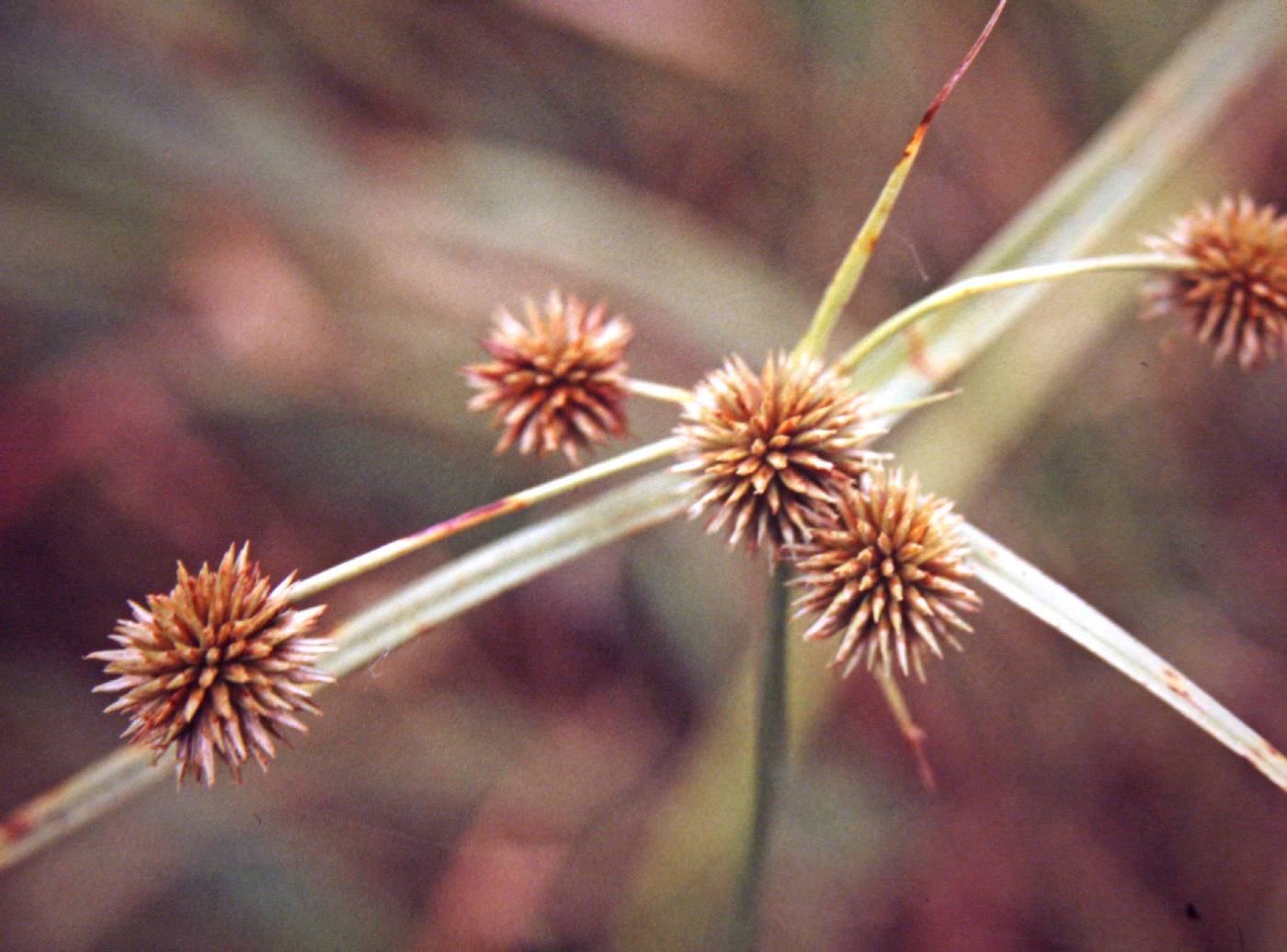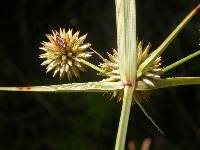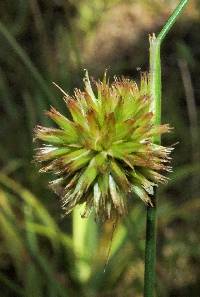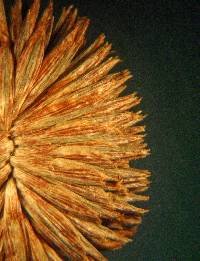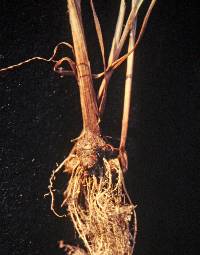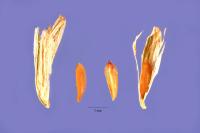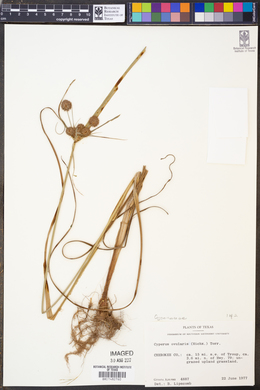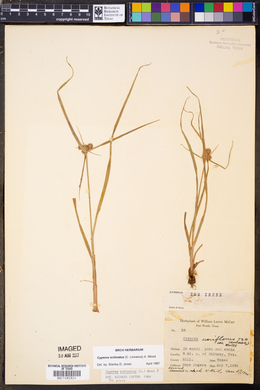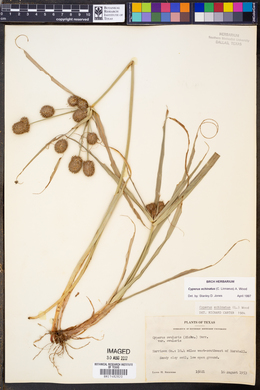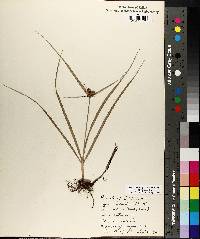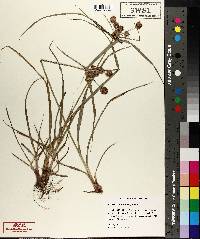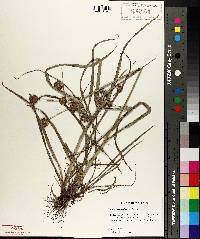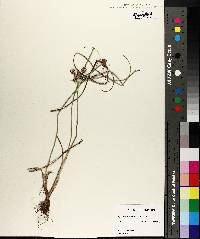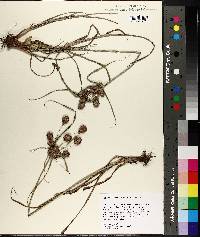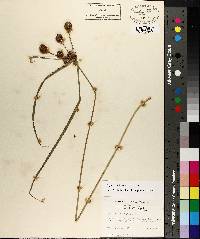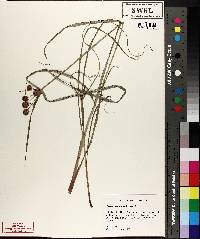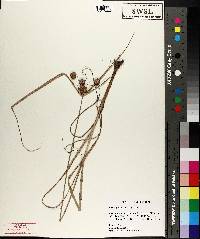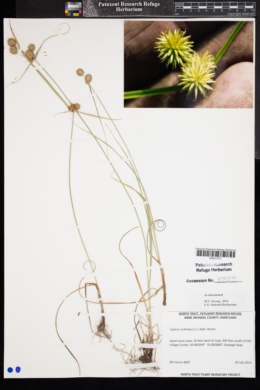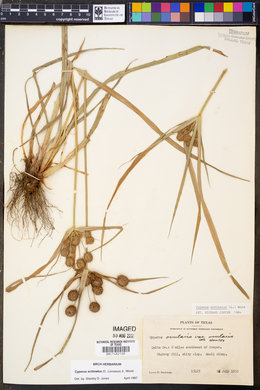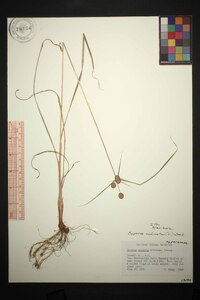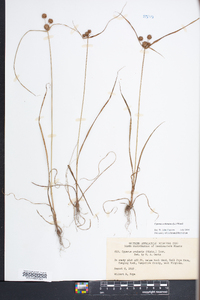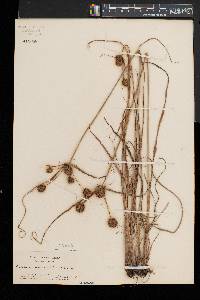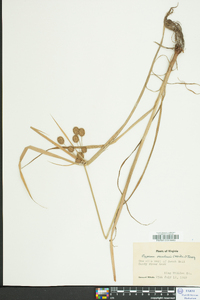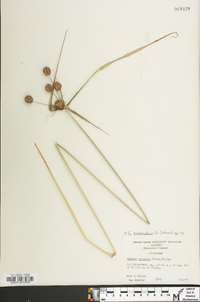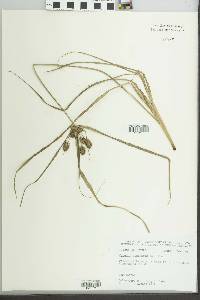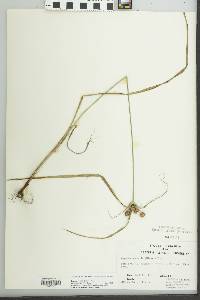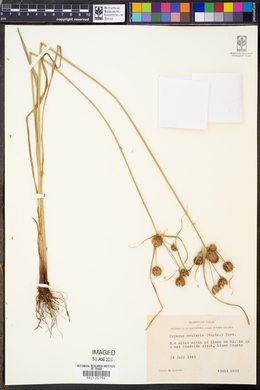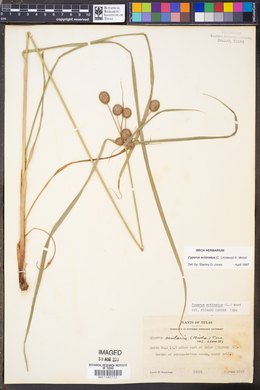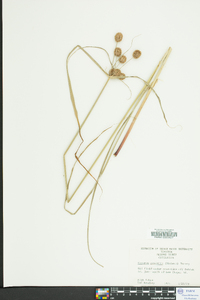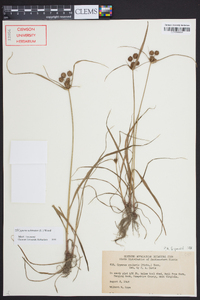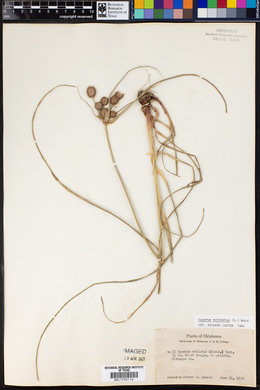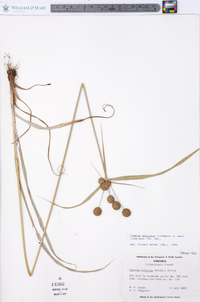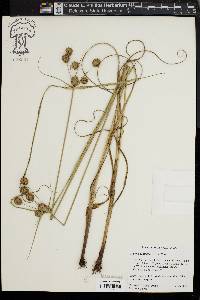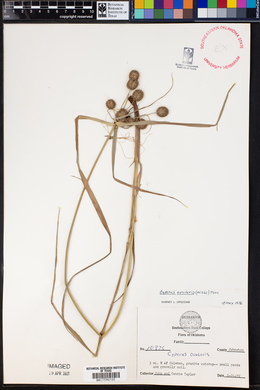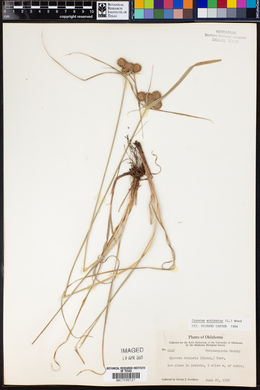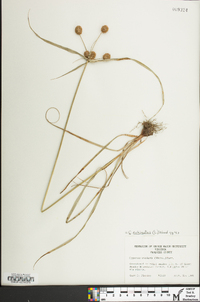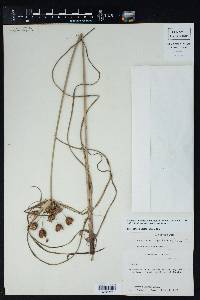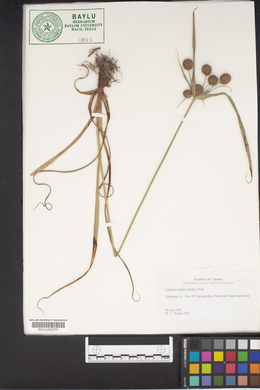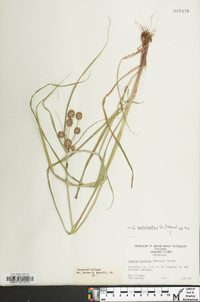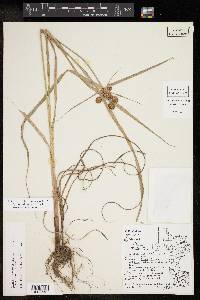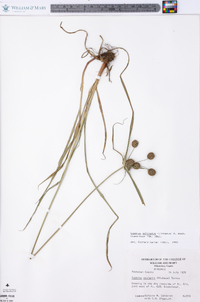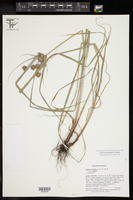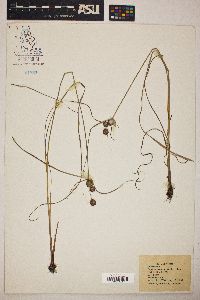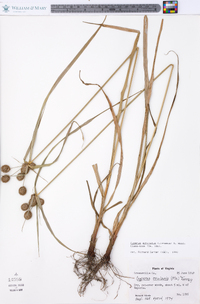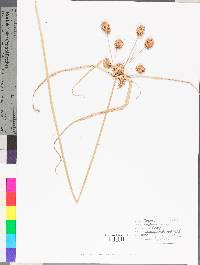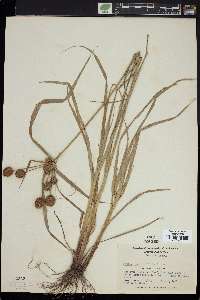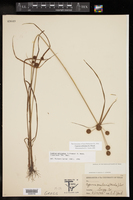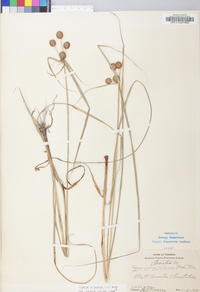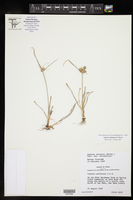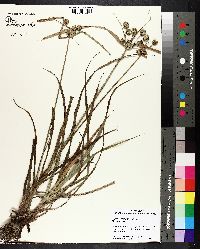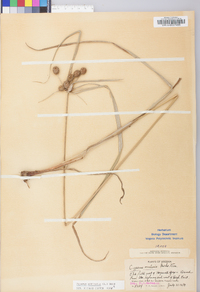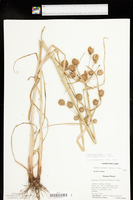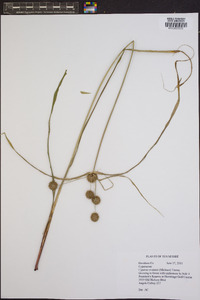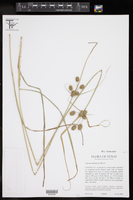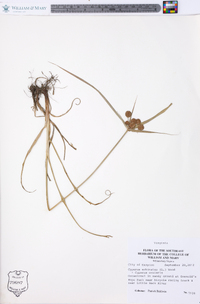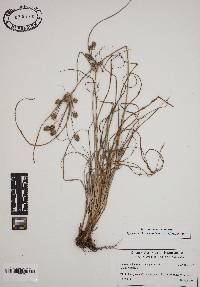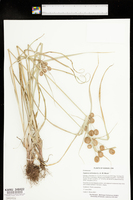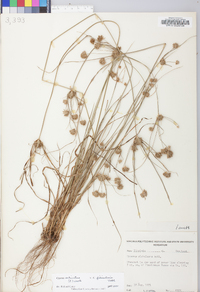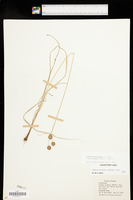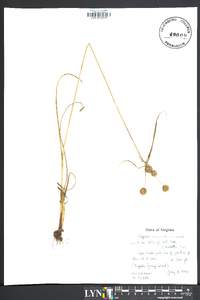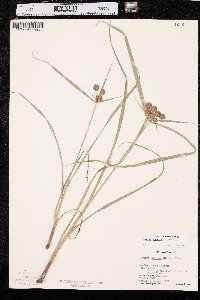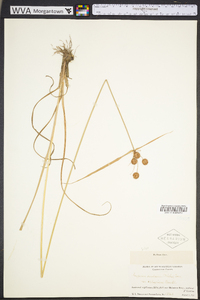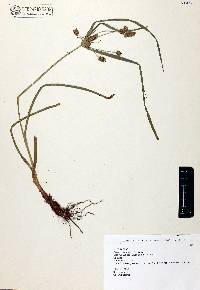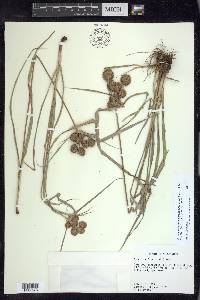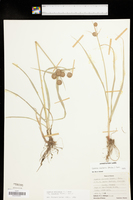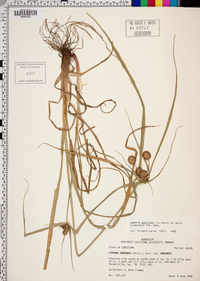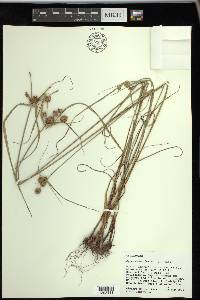
|
|
|
|
Family: Cyperaceae
Globe Flat Sedge, more...globe flatsedge
[Cyperus ovularis (Michx.) Torr., moreCyperus ovularis var. ovularis , Cyperus ovularis var. sphaericus Boeck., Cyperus wolfii , Kyllinga ovularis , Mariscus ovularis var. tenellus Torr.] |
Herbs, perennial, single-stemmed to loosely cespitose. Culms basally cormlike, trigonous, (15-)30-100 cm × 0.5-3.5 mm, glabrous. Leaves flat to V-shaped, 10-65 cm × 3-9 mm, adaxial surface, margins minutely scabridulous. Inflorescences: spikes densely globose to globose-ovoid, 8-17 mm wide; rays 3-12, 2-12 cm, scaberous adaxially especially distally; rachis 4-8 mm; bracts (3-)4-7, ascending at 30(-45)°, flat, 5-35 cm × 2-9 mm; rachilla persistent, wings 0.5-0.7 mm wide. Spikelets 50-100, oblong-lanceoloid, ± terete-quadrangular, (3.5-)4-7 × 1-1.4 mm; distal spikelet spreading or ascending; floral scales persistent, 3-5, appressed, stramineous to brownish, 4-ribbed laterally, oblong-elliptic, 3.5-4.5 × 1-1.8 mm, membranous, apex entire or emarginate with mucro to 0.3 mm. Flowers: anthers 0.4-0.8 mm; styles 0.5-0.6 mm; stigmas 1 mm. Achenes brown, ± stipitate, oblong, (1.5-)1.8-2.3 × 0.5-0.6(-0.7) mm (1/2 length of floral scales), apex obtuse, surfaces puncticulate. Fruiting summer-early fall. Disturbed, sunny sites, in mesic places, well-drained soils; 0-500 m; Ala., Ark., Del., D.C., Fla., Ga., Ill., Ind., Kans., Ky., La., Md., Miss., Mo., N.J., N.Y., N.C., Ohio, Okla., Pa., R.I., S.C., Tenn., Tex., Va., W.Va., Wis.; West Indies. The records for Rhode Island and Wisconsin are according to M. L. Horvat (1941); we have not seen specimens from those states. Cyperus echinatus is usually recognized by its tight, nearly spheric spikes; it may occasionally be hard to distinguish from C. croceus and C. retrorsus. Compared to C. retrorsus, C. echinatus has larger spikelets and longer floral scales, anthers, and achenes. In contrast to C. echinatus, C. croceus has looser spikes, shorter, broader, greenish or yellowish floral scales, shorter, more ovoid achenes, and shorter anthers. Furthermore, C. echinatus is predominantly an inland species of roadsides, pastures, and other disturbed ground; C. retrorsus is primarily a coastal species and occurs in drier, sandier sites.
Perennial herb with rhizomes and runners, one-stemmed or forming loose tufts 30 cm - 1 m tall Leaves: basal, alternate, 10 cm - 0.6 m long, 3 - 9 mm wide, flat or V-shaped in cross-section, linear, parallel-veined, keeled beneath, with a sheathing base that encloses the stem. Inflorescence: consisting of terminal spikes, subtended by spirally arranged leafy bracts. Bracts four to seven, ascending, unequal, 5 - 35 cm long, 2 - 9 mm wide, flat. Rays (branches of inflorescence) three to twelve, to 12 cm long. Spikes 8 - 15 mm wide, more or less spherical, consisting of 50 to 100 spikelets radiating in all directions. Flowers: minute, in the axil of a floral scale, lacking sepals and petals. Stamens exserted. Anthers about 0.5 mm long. Pistil one. Style about 0.5 mm long. Stigma about 1 mm long. Fruit: a one-seeded achene, short-stalked, brown, about 2 mm long and 0.5 mm wide, oblong with a rounded apex, three-angled, tiny-dotted. Seed with a thin, non-adherent wall. Culm: 30 cm - 1 m long, 0.5 - 3.5 mm wide, triangular in cross-section, solid. Spikelets: 3 - 7.5 mm long, 1 - 1.5 mm wide, oblong lance-shaped, circular to four-angled in cross-section, subtended by two small bracts, with three to five floral scales. Scales appressed, straw-colored to brown, 3.5 - 4.5 mm long, 1 - 2 mm wide, oblong-elliptic with a rounded or tiny-pointed apex, four-ribbed, membranous, lowest one empty. Similar species: No information at this time. Flowering: June to September Habitat and ecology: Probably introduced from farther south. The only confirmed Chicago Region record is from a fescue field in DuPage County, Illinois. In the southern one-third of Illinois it is common in dry sandy woods and old fields. Occurence in the Chicago region: non-native Etymology: Cyperus is the ancient Greek word for sedge. Echinatus means prickly. Author: The Morton Arboretum Perennial; stems 3-10 dm, smooth; lvs flat, 3-8 mm wide; bracts 4-7, the lowest much elongate and surpassing the infl; infl with 1 or 2 sessile terminal spikes and usually 2-10 ascending rays to 10 cm; spikes globose, 8-15 mm thick; spikelets very numerous, closely packed and radiating in all directions, 3-7.5 mm, 1-3-fld; scales oblong-elliptic, obtuse, multinerved, the lower 3.5-4.2 נ1.5-2 mm; achenes trigonous, 1.8-2.2 mm, a third as thick. Dry woods and fields; sc. Conn. and s. N.Y. to s. O., Ill., and e. Kan., s. to n. Fla. and ne. Mex. (C. ovularis) Gleason, Henry A. & Cronquist, Arthur J. 1991. Manual of vascular plants of northeastern United States and adjacent Canada. lxxv + 910 pp. ©The New York Botanical Garden. All rights reserved. Used by permission. From Flora of Indiana (1940) by Charles C. Deam This species is found in very dry to moist, sandy habitats. It is local in the southwestern counties. It has been reported from Lake County, but Geise did not find a specimen. I believe that the Lake County report should be referred to Cyperus filiculmis var. macilentus. |
This project was made possible in part by the Institute of Museum and Library Services [MG-70-19-0057-19].
Powered by Symbiota

